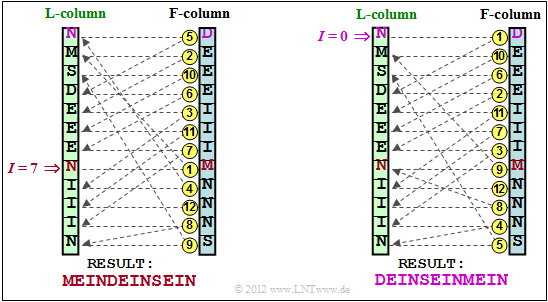Exercise 2.13: Inverse Burrows-Wheeler Transformation
The "Burrows–Wheeler Transformation" – abbreviated $\rm BWT$ – causes a blockwise sorting of the characters of a text with the aim of preparing the text for efficient data compression with the help of run-length coding or entropy coding.
- First, an $N×N$ matrix is generated from a block of length $N$, with each row of this first matrix resulting from the preceding row by cyclic left shift.
- Then the matrix is sorted lexicographically (without special characters: alphabetically) . The result of the BWT is the last row of the new BWT matrix, the so-called $\text{L column}$ (from "Last").
- Further, this task refers to the $\text{F column}$ (from "First", first row of the BWT matrix), which is needed for the inverse Burrows–Wheeler Transformation ⇒ reconstruction of the original text from the L column.
- For the inverse BWT, the so-called "primary index" $I$ is also required. This indicates the row of the BWT matrix in which the algorithm must be started.
The graphic shows the result of a BWT, more precisely its L column. The original text is to be reconstructed from this according to the description in the theory section Burrows–Wheeler Transformation,
- in subtask (2) with the primary index $I = 7$,
- in subtask (3) $I = 0$ is to be assumed.
Hints:
- The exercise belongs to the chapter Further Source Coding Methods.
- In particular, reference is made to the section Burrows–Wheeler Transformation.
Questions
Solution
- The first column of the BWT matrix is also called the "F column" and the last column the "L column" (from "First" or "Last").
- Only the "L column" is passed on to the next coding level.
- The "F column", which is also needed for the reverse transformation, results from the "L column" by lexicographically sorting.
(2) The solution suggestion 1 is correct: MEINDEINSEIN, as can be seen from the left-hand representation of the following diagram.
Note that the top line represents the line number $I = 0$ in each case. For explanation:
- Start the decoding with the line $I = 7$ of the "F column".
The content is $\rm M$. - Search for the corresponding $\rm M$ in the "L column" and find it in line number "1".
- From line 1 of the "L column" one goes horizontally to the "F column" and finds the symbol $\rm E$.
- Similarly, one finds the third output symbol $\rm I$ in line 4 of the "F column".
- The decoding algorithm ends with the output symbol $\rm N$ in the third last row.
(3) Correct is the proposed solution 2: $\rm DEINSEINMEIN$, as shown in the graph on the right.
(4) Correct is the suggested solution 3:
- In BWT, four characters here are equal to their predecessors, in the original none.
- In the "F column", even more characters would be the same as their respective predecessors (6 in total) due to the lexicographical sorting, but this sorting cannot be reversed without loss.
- Solution suggestion 1 is wrong too:
The original and BWT contain exactly the same characters $($three times $\rm E$, three times $\rm I$, three times $\rm N$ and one each of $\rm D$, $\rm M$ and $\rm S)$.

